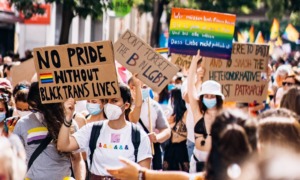 The cover of the January 2017 issue of National Geographic was a first for the historic magazine, though at first glance it seems fairly traditional: A striking 9-year-old girl looks confidently into the camera, her rainbow hair in a deep side part, her jawline set. The words “Gender Revolution” splash boldly across her chest, giving a hint to the challenges she faces.
The cover of the January 2017 issue of National Geographic was a first for the historic magazine, though at first glance it seems fairly traditional: A striking 9-year-old girl looks confidently into the camera, her rainbow hair in a deep side part, her jawline set. The words “Gender Revolution” splash boldly across her chest, giving a hint to the challenges she faces.
She is the first transgender girl featured on the cover of National Geographic.
Her name is Avery Jackson, and she represents a growing number of children navigating the world of gender transition with support from their parents and communities. When asked about the best thing about being a girl, Jackson says, “I don’t have to pretend to be a boy.”
For kids like Avery, the core of the issue is often fairly simple: Their personal gender identity differs from their sex at birth; they are transgender. The journey for families and communities attempting to support children who are questioning their gender identity, however, is often uncharted and full of challenges. Parents and caregivers face difficult decisions about how best to support their child as they explore and live their gender identity including what a transition — whether social and/or medical — would mean and how to accomplish it.
Compassionately and effectively managing transition is critical, as research documents the alarming extent of harassment and abuse transgender young people face during childhood and adolescence, and the negative effects of these on kids. Transgender kids experiencing discrimination and bullying are at an increased risk for negative mental health outcomes, including higher rates of suicide. One study found that more than half of transgender kids experiencing bullying in school had attempted suicide.
However, recent research has suggested that young people supported in social transition by their families and in their schools have the similar rates of depression as their cisgender peers (those whose personal gender identity aligns with their sex assigned at birth). Community members and youth-serving professionals also bear responsibility for creating safe and developmentally appropriate environments for transgender youth. Individuals and organizations are spearheading policy and advocacy efforts to educate families and communities, limit discrimination and improve outcomes for transgender kids through supportive family and education environments.
Advocacy is crucial, as anti-discrimination laws often do not cover transgender individuals. Additionally, state-level laws such as the infamous North Carolina “bathroom bill,” which limits sex identification to what is listed on a person’s birth certificate, directly discriminates against the transgender community. Navigating these larger issues of transphobia, as well as the daily logistics of restrooms, student records, overnight field trips and bullying pose trials for school administrators and families. Even well-intentioned individuals can make painful mistakes, such as violating a student’s privacy by talking to other parents, while trying to accommodate transition needs.
Organizations like the Human Rights Campaign (HRC), American Civil Liberties Union (ACLU) and others developed a guide for professionals and parents who work with transgender young people in schools especially. Though each transition will be personal, the guide recommends practical steps for individuals, as well as broad changes that create accepting environments for all students, such as encouraging educators of all kinds to use students’ preferred names and gender pronouns, and to use gender-inclusive language in their in- and out-of-school programming.
In addition, organizations like the Trans Youth Equity Foundation and the TransYouth Project compile resources and tools for parents, caregivers and professionals to foster healthy, safe and caring environments. Organizations like the Transgender Law Center seek to empower and protect the rights of transgender individuals, including youth. The TRUTH (Trans Youth) project shares the stories and voices of transgender young people to increase awareness and empathy, and empower these youth. These resources highlight the importance of:
- supporting healthy, self-directed transitions that respect privacy;
- promoting safe environments for all youth by reducing bullying in schools.
- developing supportive communities through education and outreach efforts;
- empowering transgender youth to be leaders and advocates for the community.
Helping transgender children and adolescents succeed begins at home with their families. But those who interact with young people regularly — teachers, counselors, mentors — also have an important responsibility to educate themselves in ways to affirm transgender youth’s journeys. Community support is crucial to navigating challenges, alleviating distress and improving outcomes.
As National Geographic Editor-in-Chief Susan Goldberg told the Huffington Post in reference to the cover, “There’s lots of coverage on celebrities, but there wasn’t an understanding on real people and the issues we face every day in classrooms or workplaces in regards to gender.” Avery Jackson is just one example of how affirming transgender youth can allow them to flourish in all aspects of their social, academic and emotional lives.
Lonna Hays is a senior associate at ICF, where she currently works with the Office of Adolescent Health’s Think, Act, Grow® initiative — a national call to action in support of America’s 42 million adolescents. Her background includes work on sexual
and reproductive health and rights, as well
as fostering healthy family relationships.
Courtney Barthle is a senior manager at ICF, where she directs projects related to self-sufficiency and populations at-risk for negative outcomes. Her current portfolio of work includes the Self-Sufficiency Research Clearinghouse and the Office of Adolescent Health’s Think, Act, Grow® initiative.































